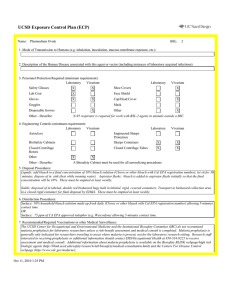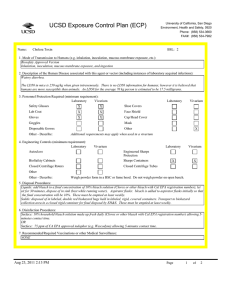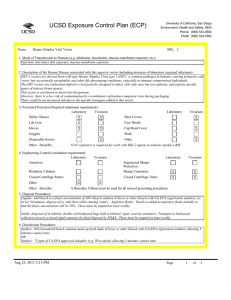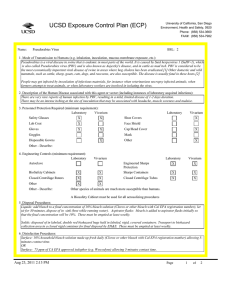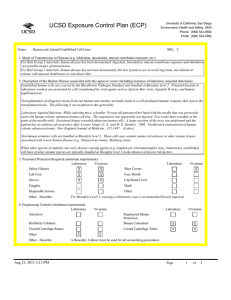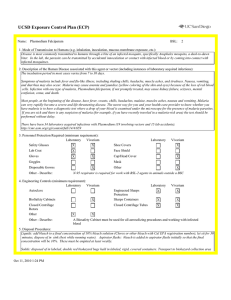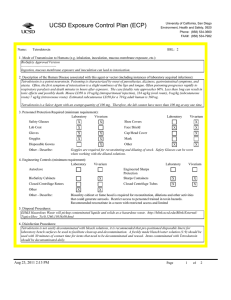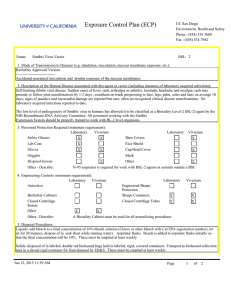UCSD Exposure Control Plan (ECP)
advertisement
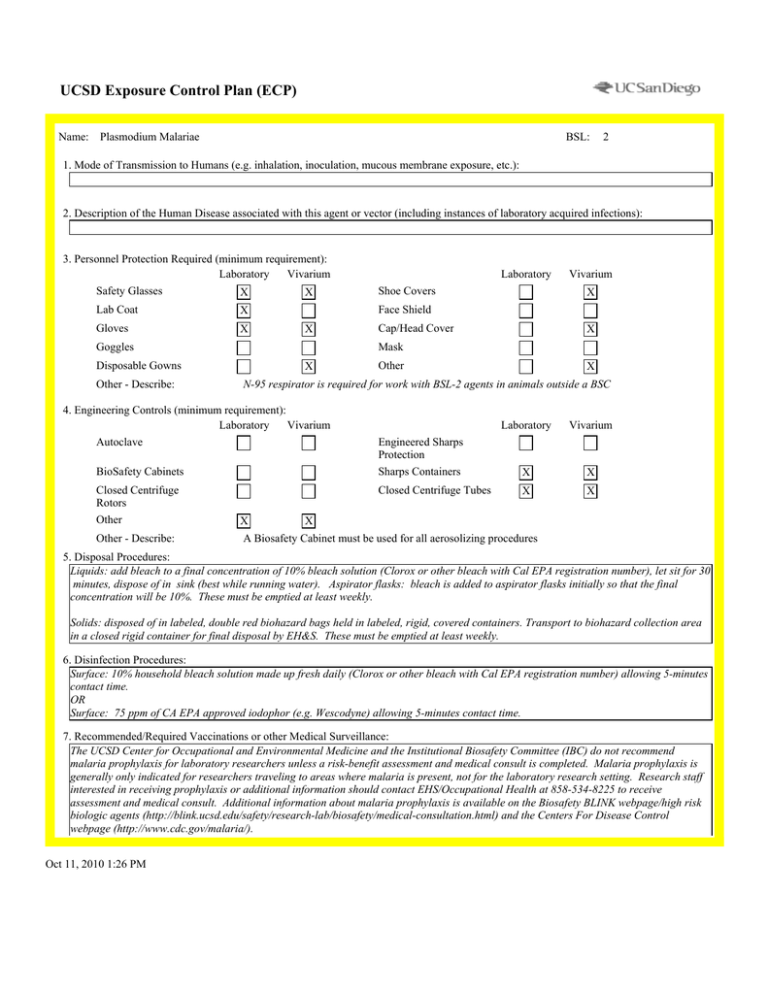
UCSD Exposure Control Plan (ECP) Name: Plasmodium Malariae BSL: 2 1. Mode of Transmission to Humans (e.g. inhalation, inoculation, mucous membrane exposure, etc.): 2. Description of the Human Disease associated with this agent or vector (including instances of laboratory acquired infections): 3. Personnel Protection Required (minimum requirement): Laboratory Vivarium Safety Glasses X X Lab Coat X Gloves X Vivarium X Face Shield X Goggles Cap/Head Cover X Mask Disposable Gowns Other - Describe: Laboratory Shoe Covers X Other X N-95 respirator is required for work with BSL-2 agents in animals outside a BSC 4. Engineering Controls (minimum requirement): Laboratory Vivarium Autoclave BioSafety Cabinets Laboratory Vivarium Engineered Sharps Protection Sharps Containers X X Closed Centrifuge Tubes X X Closed Centrifuge Rotors Other X Other - Describe: A Biosafety Cabinet must be used for all aerosolizing procedures X 5. Disposal Procedures: Liquids: add bleach to a final concentration of 10% bleach solution (Clorox or other bleach with Cal EPA registration number), let sit for 30 minutes, dispose of in sink (best while running water). Aspirator flasks: bleach is added to aspirator flasks initially so that the final concentration will be 10%. These must be emptied at least weekly. Solids: disposed of in labeled, double red biohazard bags held in labeled, rigid, covered containers. Transport to biohazard collection area in a closed rigid container for final disposal by EH&S. These must be emptied at least weekly. 6. Disinfection Procedures: Surface: 10% household bleach solution made up fresh daily (Clorox or other bleach with Cal EPA registration number) allowing 5-minutes contact time. OR Surface: 75 ppm of CA EPA approved iodophor (e.g. Wescodyne) allowing 5-minutes contact time. 7. Recommended/Required Vaccinations or other Medical Surveillance: The UCSD Center for Occupational and Environmental Medicine and the Institutional Biosafety Committee (IBC) do not recommend malaria prophylaxis for laboratory researchers unless a risk-benefit assessment and medical consult is completed. Malaria prophylaxis is generally only indicated for researchers traveling to areas where malaria is present, not for the laboratory research setting. Research staff interested in receiving prophylaxis or additional information should contact EHS/Occupational Health at 858-534-8225 to receive assessment and medical consult. Additional information about malaria prophylaxis is available on the Biosafety BLINK webpage/high risk biologic agents (http://blink.ucsd.edu/safety/research-lab/biosafety/medical-consultation.html) and the Centers For Disease Control webpage (http://www.cdc.gov/malaria/). Oct 11, 2010 1:26 PM Website for clinicians treating malaria: http://www.cdc.gov/malaria/diagnosis_treatment/tx_clinicians.htm 8. Employee Exposures- first aid procedures: a.Eye exposure from splash or aerosols - rinse a minimum of 15 minutes in eye wash or flush area with water. b.Skin exposure - wash area with soap and water for 15 minutes c.Needle stick and/or sharps exposure - wash wound area with soap and water for 15 minutes d.Contamination of clothing - remove the contaminated clothing and place in biohazard bag, shower with the emergency douse shower, and put on clean clothes. e.Spill or release - Monday through Friday, 8a - 4:30p call EH&S at (858-5343660); after hours call UCSD Police (858-534-4357) 9. Employee Exposure - seek medical follow-up from the following medical providers: (TAKE THIS ECP WITH YOU) Monday - Friday, 8a - 4:30p: UCSD Occupational & Environmental Medicine, (619) 471-9210 24-hour walk-in service: Thornton Hospital Emergency Room, (858) 657-7600 UCSD Medical Center (Hillcrest) Emergency Room, (619) 543-6400 10. Report All Injuries, Illnesses, and Exposures to EH&S: Complete the information found on "What to Do if a Work-Related Injury or Illness Occurs" (http://blink.ucsd.edu/Blink/External/Topics/ How_To/0,1260,4295,00.html) 11. Required Biosafety Training: Laboratory specific training on hazards, exposure evaluations, and the required precautions for experimental procedures used with this agent - provided by Principal Investigator Oct 11, 2010 1:26 PM
